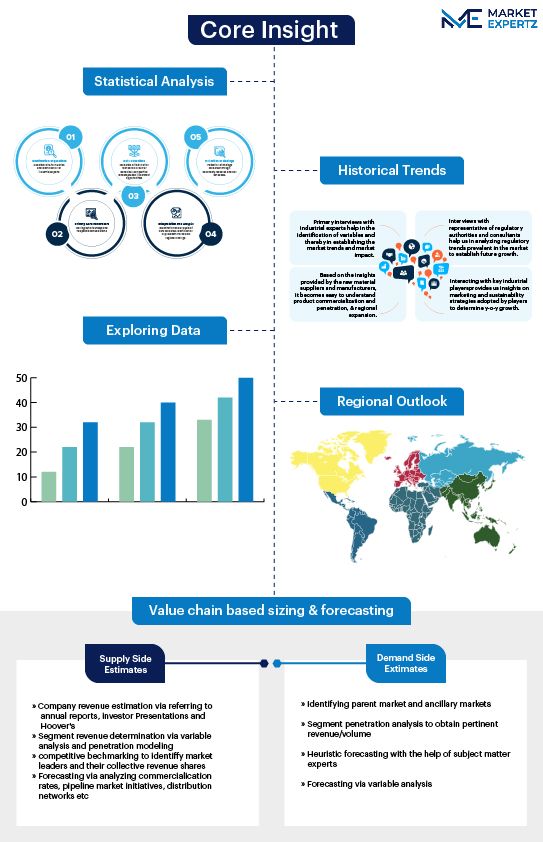
Hepatocellular Carcinoma Treatment Market By Treatment Outlook, By Drug Class Outlook, By Product Type Outlook, By Route of Administration, By Distribution Channel Outlook, By End-User Outlook and By Region Forecast To 2023-2032
- Report ID: ME_00132405
- Format: Electronic (PDF)
- Publish Type: Publish
- Number of Pages: 250
Market Snapshot
| Study Period | 2019-2032 |
| Base Year | 2023 |
| Forcast Year | 2023-2032 |
| CAGR | 7.6 |


Gain accurate insights regarding the negative impacts of COVID-19 on all markets and industries
Download Sample PdfReport Overview
The Hepatocellular Carcinoma (HCC) Treatment Market size is estimated to grow at a CAGR of 5.25% between 2023 and 2032. The growth of the market depends on several factors, including the rising incidence of hepatocellular carcinoma, advancements in treatment options, and increased awareness of liver cancer. Hepatocellular carcinoma is the most common type of primary liver cancer and is characterized by the malignant growth of liver cells. Effective treatment strategies are crucial in managing this disease.
Hepatocellular Carcinoma Treatment Market Overview:
Drivers:
One of the key factors driving the hepatocellular carcinoma treatment market growth is the rising incidence of liver cancer worldwide. Hepatocellular carcinoma accounts for a significant portion of liver cancer cases, and its prevalence has been increasing in recent years. Factors such as hepatitis B and C infections, alcohol consumption, and non-alcoholic fatty liver disease contribute to the development of hepatocellular carcinoma. As a result, there is a growing demand for effective treatment options to combat this disease.
Moreover, advancements in treatment options, including surgical interventions, liver transplantation, radiofrequency ablation, and targeted therapies, have improved the prognosis of hepatocellular carcinoma patients. The availability of more precise diagnostic tools and personalized treatment approaches further drives market growth.
Trends:
A key trend shaping the hepatocellular carcinoma treatment market is the emergence of immunotherapies as a promising treatment modality. Immunotherapeutic agents, such as immune checkpoint inhibitors, have shown significant potential in treating hepatocellular carcinoma. These therapies harness the patient's immune system to target and destroy cancer cells. The increasing research and development efforts in immunotherapy for hepatocellular carcinoma are expected to drive market growth.
Additionally, the integration of artificial intelligence (AI) and machine learning (ML) in diagnosing and monitoring hepatocellular carcinoma is another notable trend. AI-powered algorithms can assist in the early detection of liver lesions and provide valuable insights for treatment decisions. The adoption of AI-driven solutions in healthcare is likely to impact the market positively.
Restraints:
One of the challenges hindering the hepatocellular carcinoma treatment market is the high cost of certain treatment modalities. Advanced therapies, such as targeted therapies and immunotherapies, can be expensive, making them less accessible to a significant portion of the population. This cost barrier can limit the adoption of these treatments, especially in regions with limited healthcare resources.
Furthermore, the complexity of hepatocellular carcinoma, its resistance to some treatments, and the potential for adverse effects pose challenges for clinicians in selecting the most suitable treatment approach for individual patients. Overcoming these challenges through research and innovation remains a priority for the healthcare industry.
Hepatocellular Carcinoma Treatment Market Segmentation by Treatment Modality:
The surgical interventions segment is estimated to witness significant growth during the forecast period. Surgical procedures, such as hepatectomy and liver transplantation, play a crucial role in the curative treatment of hepatocellular carcinoma. Hepatectomy involves the surgical removal of a portion of the liver affected by cancer, while liver transplantation replaces the diseased liver with a healthy one. These procedures offer the potential for long-term survival and are often considered for eligible patients.
Another important treatment modality is radiofrequency ablation (RFA), which utilizes thermal energy to destroy cancerous tissue in the liver. RFA is a minimally invasive approach and is suitable for patients with early-stage hepatocellular carcinoma.
Targeted therapies, such as sorafenib and lenvatinib, are also widely used in the treatment of advanced hepatocellular carcinoma. These drugs inhibit specific molecular pathways involved in cancer growth and are administered orally.
Hepatocellular Carcinoma Treatment Market Segmentation by Region:
North America is estimated to contribute significantly to the global market during the forecast period. The region's advanced healthcare infrastructure, high prevalence of hepatocellular carcinoma, and a strong focus on research and development contribute to its market dominance. Additionally, regulatory approvals for innovative treatments and the presence of key market players in North America further drive market growth.
Europe, with countries like the United Kingdom, Germany, and France, also plays a substantial role in the hepatocellular carcinoma treatment market. The region benefits from well-established healthcare systems and a growing emphasis on early cancer detection and treatment.
In Asia-Pacific (APAC), particularly in countries like China and India, the rising incidence of liver cancer and increasing healthcare investments fuel market growth. The availability of cost-effective treatment options and a large patient population drive demand for hepatocellular carcinoma treatments in the region.
Hepatocellular Carcinoma Treatment Market Customer Landscape:
The hepatocellular carcinoma treatment market report includes insights into the customer landscape, including healthcare providers, patients, and pharmaceutical companies. Understanding the needs and preferences of these stakeholders is essential for market players to tailor their strategies and offerings effectively.
Major Hepatocellular Carcinoma Treatment Market Companies:
Companies in the hepatocellular carcinoma treatment market are actively engaged in research and development to bring innovative therapies to the market. They also explore strategic collaborations and partnerships to expand their product portfolios and geographic reach.
Some of the major companies operating in the hepatocellular carcinoma treatment market include:
- Bayer AG
- Bristol Myers Squibb Company
- F. Hoffmann-La Roche Ltd.
- Gilead Sciences, Inc.
- Ipsen S.A.
- Merck KGaA
- Novartis AG
- Ono Pharmaceutical Co., Ltd.
- Pfizer, Inc.
- Eisai Co., Ltd.
These companies offer a range of treatment options, including targeted therapies, immunotherapies, and supportive care medications, to address the diverse needs of hepatocellular carcinoma patients.
Segment Overview:
The hepatocellular carcinoma treatment market report provides comprehensive market insights, including revenue forecasts at global, regional, and country levels. The segmentation includes:
Treatment Outlook
- Targeted drug treatment
- Anti-angiogenesis drugs
- Immunotherapy treatment
- Immune checkpoint inhibitors
Drug Class Outlook
- Tyrosine kinase inhibitors
- PD-1/PD-L1 inhibitors
- Product Outlook
- Capsules
- Tablets
- Intravenous infusion
Route of Administration Outlook
- Oral
- Parenteral
Distribution Channels Outlook
- Online
- Offline
End-user Outlook
- Hospitals
- Speciality clinics
- Others
Region Outlook (USD Million, 2019 - 2032)
-
- North America
- The U.S.
- Canada
- Europe
- U.K.
- Germany
- France
- Rest of Europe
- APAC
- China
- India
- South America
- Chile
- Argentina
- Brazil
- Middle East & Africa
- Saudi Arabia
- South Africa
- Rest of the Middle East & Africa
- North America
RESEARCH METHODOLOGY
A research methodology is a systematic approach for assessing or conducting a market study. Researchers tend to draw on a variety of both qualitative and quantitative study methods, inclusive of investigations, survey, secondary data and market observation.
Such plans can focus on classifying the products offered by leading market players or simply use statistical models to interpret observations or test hypotheses. While some methods aim for a detailed description of the factors behind an observation, others present the context of the current market scenario.
Now let’s take a closer look at the research methods here.
Secondary Research Model
Extensive data is obtained and cumulated on a substantial basis during the inception phase of the research process. The data accumulated is consistently filtered through validation from the in-house database, paid sources as well reputable industry magazines. A robust research study requires an understanding of the overall value chain. Annual reports and financials of industry players are studied thoroughly to have a comprehensive idea of the market taxonomy.
Primary Insights
Post conglomeration of the data obtained through secondary research; a validation process is initiated to verify the numbers or figures. This process is usually performed by having a detailed discussion with the industry experts.
However, we do not restrict our primary interviews only to the industry leaders. Our team covers the entire value chain while verifying the data. A significant number of raw material suppliers, local manufacturers, distributors, and stakeholders are interviewed to make our findings authentic. The current trends which include the drivers, restraints, and opportunities are also derived through the primary research process.
Market Estimation
The market estimation is conducted by analyzing the data collected through both secondary and primary research. This process involves market breakdown, bottom-up and top- down approach.
Moreover, while forecasting the market a comprehensive statistical time series model is designed for each market. Macroeconomic indicators are considered to understand the current trends of the market. Each data point is verified by the process of data triangulation method to arrive at the final market estimates.
Final Presentation
The penultimate process results in a holistic research report. The study equips key industry players to undertake significant strategic decisions through the findings. The report encompasses detailed market information. Graphical representations of the current market trends are also made available in order to make the study highly comprehensible for the reader.
Personalized Business Report Tailored to Your Requirements
- Our expert analysts collaborate directly with you to comprehend your specific needs.
- Get data on regions, segments, competitors, and vendors of your choice.
- Information is presented in alignment with your exact preferences and formatting.
Free Sample Report
"Find new revenue generation opportunities"
